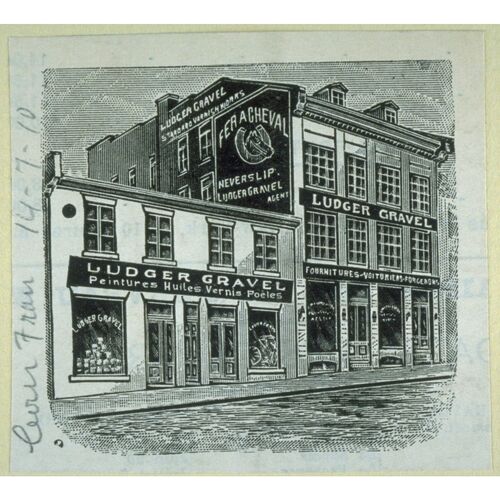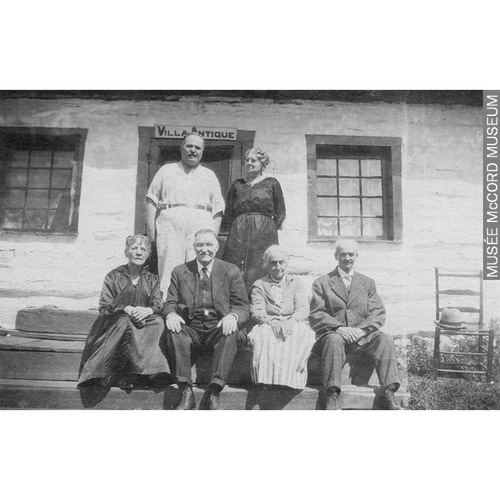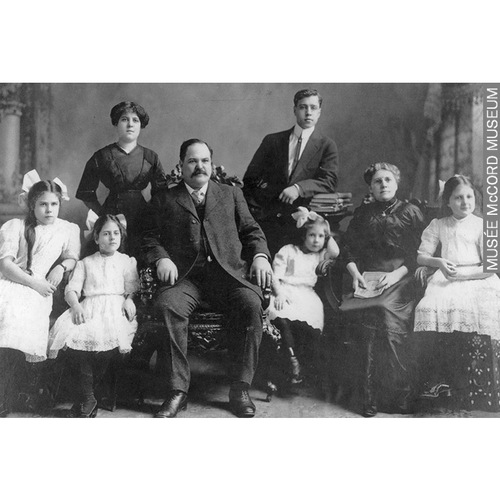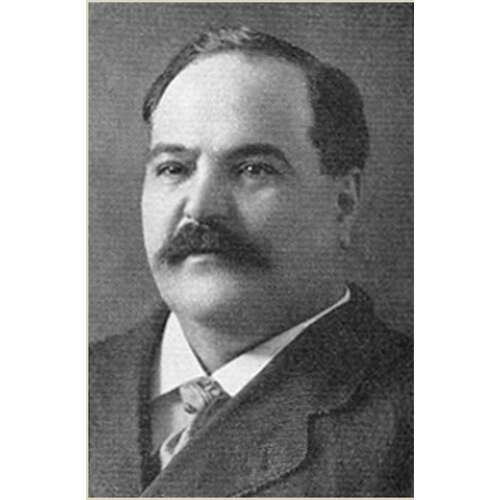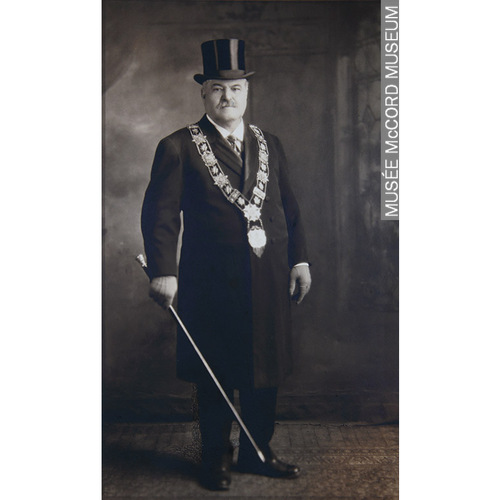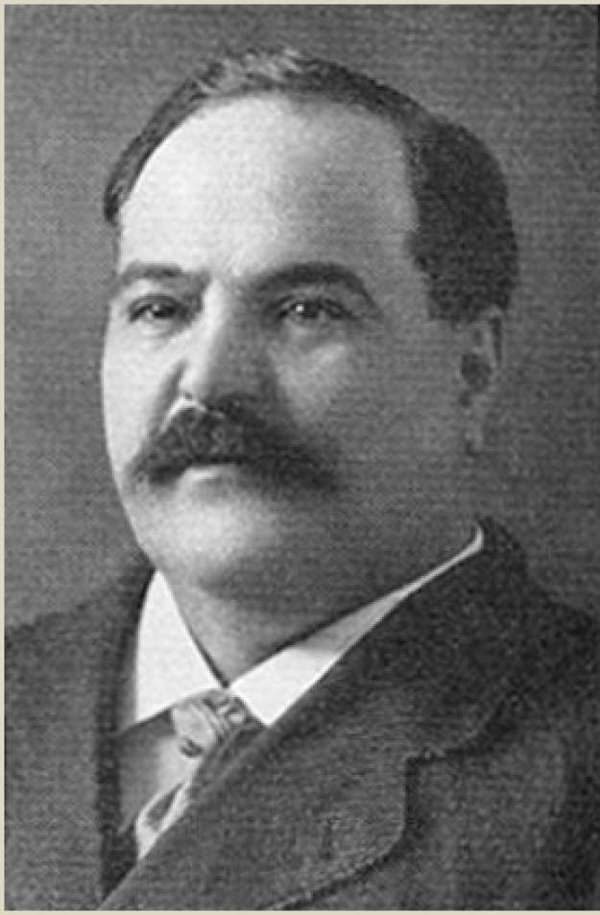
Source: Link
GRAVEL, LUDGER (baptized Joseph-Jacques), businessman, philanthropist, politician, and collector; b. 6 Nov. 1864 in the parish of Saint-Raphaël-Archange on Île Bizard, Lower Canada, son of Léon Gravel and Marie Lauzon, farmers; m. 26 May 1891 Sophie (also called Laura) Roy (d. 26 Nov. 1943) in Montreal, and they had 14 children; d. there 6 April 1933.
Ludger Gravel was descended from Joseph-Massé Gravel, dit Brindelière, who had come to New France from Brittany in 1641. In 1872 Ludger’s family moved from Île Bizard to Montreal, where he was educated by the Brothers of the Christian Schools. At 16 he entered the hardware business of Thomas Wilson in Montreal. Wilson collected coins, medals, and historical artefacts, and apparently imparted this passion to Ludger.
Gravel moved to a clerkship with the business run by Pierre-Philias Mailloux and Maurice Barsalou in 1881; he soon became a commercial traveller and then manager of their wholesale firm. The stocky, irrepressibly vigorous young man rose quickly. Good-humoured and sociable, he was a poet and a storyteller, with a gift for marketing. In 1892 he introduced Balmoral brand oil for wagon axles and machinery and Sara oil to the company’s customers. Promotions such as minted tokens for cans of Balmoral oil, umbrellas, cigars with labels bearing his name, and other souvenirs were effective devices. So too was the patriotic gimmickry of his Recueil de légendes illustrées (Montréal, 1896), a booklet of advertisements and stories: it included a version of Benjamin Sulte*’s account of Jos Montferrand [Joseph Montferrand*, dit Favre]; “Les trois diables”; and a tale by Louis Fréchette*, based on a vagabond he had met named Olivier Chouinard.
In 1901 Gravel bought Mailloux’s business (Barsalou had left earlier), which then handled a wide range of oils, finishes, hardware, and other supplies, mostly for carriage builders and blacksmiths. Situated on Place Jacques-Cartier, it flourished as Gravel’s entrepreneurial instinct bore more fruit. A printing operation was added in 1904 to meet his mercantile needs and take on piecework. By 1907 his business was the exclusive distributor and agent in Quebec and the Maritimes for more than 20 manufacturers. His bilingual catalogues, first introduced in 1909, were being delivered via motorcycle by 1920.
As early as 1904 Gravel had seen potential in motorization trends, including business opportunities for building better roads. Between 1907 and 1910, partly on the grounds of public sanitation, he flogged a proposal for paving Montreal’s streets with asphalt blocks made in Walkerville (Windsor), Ont., and the city eventually agreed to do so. Of greater consequence, Ludger Gravel et Fils, formed in 1917 with his son Pierre-Ludger, a commerce graduate of the Collège du Mont-Saint-Louis, consolidated Gravel Sr’s specialization in automotive supplies and garage equipment. The company, which would count some 40 employees by the mid 1920s, filled an important niche in the automotive trade in Quebec [see Joseph-Charles-Émile Trudeau; Pierre-Théophile Legaré*]. Other extensions included Gravel et Drouin Limitée, which had opened by 1922 to supply bulk iron and ornamental and architectural ironwork.
Long a theatre devotee, Gravel, with Léo-Ernest Ouimet* and others in 1922, formed Laval Photoplays Limited, a cinematic venture. One of its first showings, the silent film Why Get Married?, known in French as Pourquoi se marier?, was initially rejected in 1924 by the Canadian censors [see Georges Alba*]. An acceptable edited version failed, but Gravel was rarely daunted.
With his rise in business came participation in a host of related associations. As well as holding memberships in a number of auto-equipment associations, he was a delegate to the meeting in England of the Canadian Manufacturers’ Association (1905), president of the Commercial Travellers’ Association of Canada (1915) and the Chambre de Commerce du District de Montréal (1916), and vice-president of the Fédération des Chambres de Commerce de la Province de Québec (1927). In 1913–14 he headed the Montreal chamber’s permanent commissions on municipal affairs and iron and metals. In 1917, as part of a delegation of the wartime Bonne Entente movement [see Sir Lomer Gouin*], he visited Ontario, where some of the companies he represented were situated.
Public-minded from an early age, the jovial, ever-generous Gravel had achieved philanthropic prominence while in his thirties, notably in the mutual-aid movement (insurance and other benefits) in Quebec [see Louis Archambault*]. First elected to the executive of the Société des Artisans Canadiens-Français in 1903, he served as a vice-president and, in 1910–14, as president. In 1905 he attended the Congrès International de la Mutualité in Liège, Belgium. As a constant presence at charitable and social functions, he personified his claim, made in 1906 in a bilingual souvenir pamphlet printed for his customers, that “gaity is the characteristic of our race.”
Gravel devoted time to many causes, including hospitals and other charitable bodies, amateur choral and theatrical presentations, prizes for sport, the needs of the Roman Catholic Chinese community of Montreal, and public education. He was particularly committed to the welfare of his fellow French Canadians. A one-time director of the Montreal Technical School, between 1921 and 1928 he represented the central district on the Montreal Catholic School Commission, where he fought for quality bilingual instruction and which he considered essential. In 1927 Gravel (a discreet Liberal in politics) was also a city alderman, in which capacity he attempted to have youths under 16 barred from cinemas and gaming halls. For his many contributions he was lauded and decorated, notably by the Equestrian Order of the Holy Sepulchre of Jerusalem and the governments of France and China.
Gravel became equally well known for his numismatic activity, and Montreal was a centre of collecting and research during his lifetime. A serious collector since at least 1889, he was a member of the Numismatic and Antiquarian Society of Montreal by 1895 and belonged to its executive from 1902. As in his business, his educational and mutual-aid pursuits had numismatic dimensions. In 1901 he had begun donating to the school board the Ludger Gravel Medal, as well as certificates, for student achievement in arithmetic; for a conference of the Société des Artisans Canadiens-Français in 1906 he had a special souvenir medal made. In 1908 he joined the prestigious American Numismatic Association (ANA); his affability made him suited to head the organizing and entertainment committees for its conventions in Montreal in 1909 and 1923, and he served as a vice-president, governor, and librarian. At a social event called a smoker during the sometimes-boisterous 1909 convention, he had sung what Mehl’s Numismatic Monthly described as “a potpourri of fifty-seven different French chansonettes.” One focus of the Numismatic and Antiquarian Society of Montreal, and of the conventions, was the preservation of the Château Ramezay, which it converted into a museum in 1895, leasing it from the city until 1929 when it would be given to the group. Gravel had served as its governor as early as 1904. Later a vice-president, in 1926 he was instrumental in securing for the château the major numismatic collection of protonotary Robert Wallace McLachlan. Gravel had himself acquired coins, tokens, and historical medals of Canadian significance, many from the period of the French regime and the pre-confederation era. He rates, along with McLachlan and Montreal paper-manufacturer William Walter Coulthard Wilson, as one of the most prominent numismatists of his era in Canada.
The broad, and very eclectic, collecting interests of Gravel were held together by his passion for preserving French Canadian heritage, including his own genealogical past. His summer home from 1908, Villa des Montagnes, was part of a cottage community northwest of Montreal near Saint-Canut (Mirabel), his wife’s birthplace. There he converted an ancient log house into a museum, Villa Antique, and jammed it with artefacts: French Canadian attire, stuffed animals, furniture, arms, literature, and coin and medal collections. His cottage became a hub of family and club gatherings, a place where the Gravel children grew up with fond memories of swimming, boating, and riding in sporty cars.
Ludger Gravel’s death from a heart attack in April 1933 was met with a stream of lament and tribute, much of it warmly recorded in the biography written by his granddaughter Laurette B. Richer. Buried in Montreal’s Notre-Dame-des-Neiges cemetery, “le bon M. Gravel,” as he would be described in his obituary in La Revue moderne (Montreal), was survived by his wife, son Pierre-Ludger, and five daughters. In 2014 he was inducted into the ANA’s Numismatic Hall of Fame.
For their assistance, the author wishes to thank Darryl A. Atchison, editor of the Canadian numismatic bibliography … (2v., [Willowdale, Ont.?], 2007); Warren Baker, Montreal; Paul Berry of the Bank of Can. Museum, Ottawa; Francis D. Campbell of the American Numismatic Soc., Harry W. Bass Jr Library, New York; Daniel Gosling and Paul Petch of the Royal Canadian Numismatic Assoc. Library, Sherwood Park, Alta; and Ronald A. Greene of the Canadian Numismatic Research Soc., Victoria.
Ludger Gravel’s Recueil de légendes illustrées (Montréal, 1896) has been made available on microfiche by CIHM (no.16887). Selections from his numismatic collections are listed in two illustrated catalogues at the Toronto Public Library: Part of the important numismatic collection formed by the late Ludger Gravel: Montreal, Canada: part I on historical medals (Montreal, 1930); and Clearance sale of the balance of medals of the famous museum of the late Ludger Gravel ([Montreal], 1939). Among the records of the American Numismatic Soc. at Harry W. Bass Jr Library is another auction catalogue: Sale number 356: rare Canadian and United States coins and medals, the property of the late Ludger Gravel, of Montreal; Byron Carney, of London, Ontario; and other collectors, comp. Wayte Raymond and J. G. Macallister (New York, 1935). Two price lists, for medals offered for sale in 1937 by Ludger Gravel et Fils Limitée of Montreal, are part of the National Currency Coll. at the Bank of Can. Museum. Other price lists, dated 1938 and 1939, are listed in the Canadian numismatic bibliography. Despite the recognition Gravel received for his achievements, no comprehensive critical analysis of his collections has been found.
Official sources contain several variations of the first name(s) of Ludger Gravel’s mother: Marie on her baptismal record (BANQ-CAM, CE601-S28, 29 oct. 1825); Denise Delima on her marriage record, unsigned (BANQ-CAM, CE601-S28, 27 févr. 1843); Adeline in the 1871 census (LAC, R233-34-0, Que., dist. Beauharnois (111), subdist. St Clément (A): 19); Melina in the 1881 census (LAC, R233-35-2, Que., dist. Montreal (90), subdist. St Louis Ward (E): 136); and Adéline in the 1891 census (LAC, R233-36-4, Que., dist. Montreal (172), subdist. St Louis Ward (G): 22–23).
J.‑L. Giroux’s “A short biography of Ludger Gravel,” Canadian Numismatic Journal (Markham, Ont.), 30 (1985): 374–76, is a translation of his article written in French, “Une brève biographie de Ludger Gravel,” which appeared in the same edition of the Canadian Numismatic Journal on pages 124 to 126. The French version was originally published as “Brève biographie de Monsieur Ludger Gravel,” Soc. Numismatique du Québec, Bull. de liaison (Sillery, Québec), février 1985: 4–5.
BANQ-CAM, CE601-S7, 26 mai 1891; CE601-S56, 6 nov. 1864. McCord Museum (Montreal), P091 (Ludger Gravel fonds). Le Devoir, 12 déc. 1925; 6, 10 avril 1933. New York Times, 7 April 1933. La Patrie, 19 juill. 1902. “American Numismatic Association convention at Montreal,” Numismatist (Philadelphia, etc.), 22 (1909): 257–65. BCF, 1924. Fred Bowman, “The case of the bouquet sou Breton 712,” Canadian Numismatic Journal, 2 (1957): 63–65. P. N. Breton, Popular illustrated guide to Canadian coins, medals, &. &. (Montreal, 1912). Chambre de Commerce du District de Montréal, Bull. (Montréal), avril 1913. Dictionnaire de la censure au Québec: littérature et cinéma, sous la dir. de Pierre Hébert et al. ([Saint-Laurent, Québec], 2006). Directory, Montreal, 1918–23. F. G. Duffield and “L’Alouette,” “The 1909 Montreal convention of the American Numismatic Association,” Mehl’s Numismatic Monthly (Fort Worth, Tex.), 2 (1909): 129–47. Encyclopaedia of Canadian biography …, vol.3. “Ludger Gravel,” Numismatist, 46 (1933): 333–34. “Proceedings of the annual convention of the American Numismatic Association held at Montreal, Canada, August 25 to 30, 1923,” Numismatist, 36 (1923): 436–41, 470–92. J. [H.] Remick, “Ludger Gravel,” Canadian Token (Hamilton, Ont.), 18 (1989): 73–75. Laurette B.[-] Richer, Ludger Gravel, 1864–1933: contre l’oubli ([Montréal], 1986). Soc. Saint-Jean-Baptiste de Montréal, 70ème anniversaire de l’Association nationale St-Jean-Baptiste, Montréal, 1834–1904 (Montréal, [1904]), 35. The storied province of Quebec: past and present, ed. W. [C. H.] Wood et al. (5v., Toronto, 1931–1932), 3: 154–55.
Cite This Article
David Roberts, “GRAVEL, LUDGER (baptized Joseph-Jacques),” in Dictionary of Canadian Biography, vol. 16, University of Toronto/Université Laval, 2003–, accessed December 4, 2025, https://www.biographi.ca/en/bio/gravel_ludger_16E.html.
The citation above shows the format for footnotes and endnotes according to the Chicago manual of style (16th edition). Information to be used in other citation formats:
| Permalink: | https://www.biographi.ca/en/bio/gravel_ludger_16E.html |
| Author of Article: | David Roberts |
| Title of Article: | GRAVEL, LUDGER (baptized Joseph-Jacques) |
| Publication Name: | Dictionary of Canadian Biography, vol. 16 |
| Publisher: | University of Toronto/Université Laval |
| Year of publication: | 2021 |
| Year of revision: | 2021 |
| Access Date: | December 4, 2025 |


